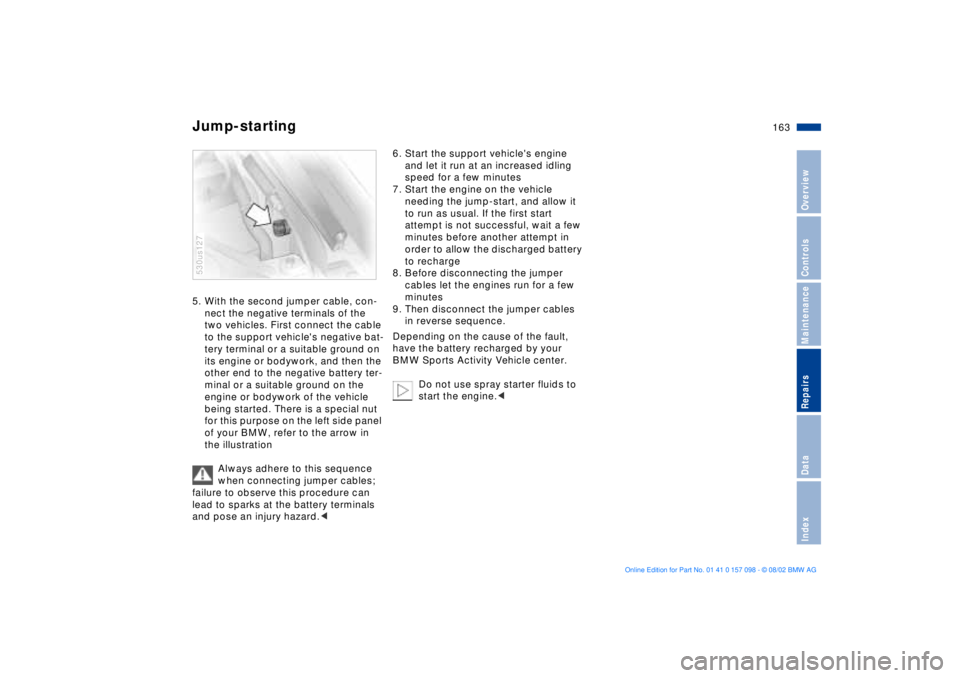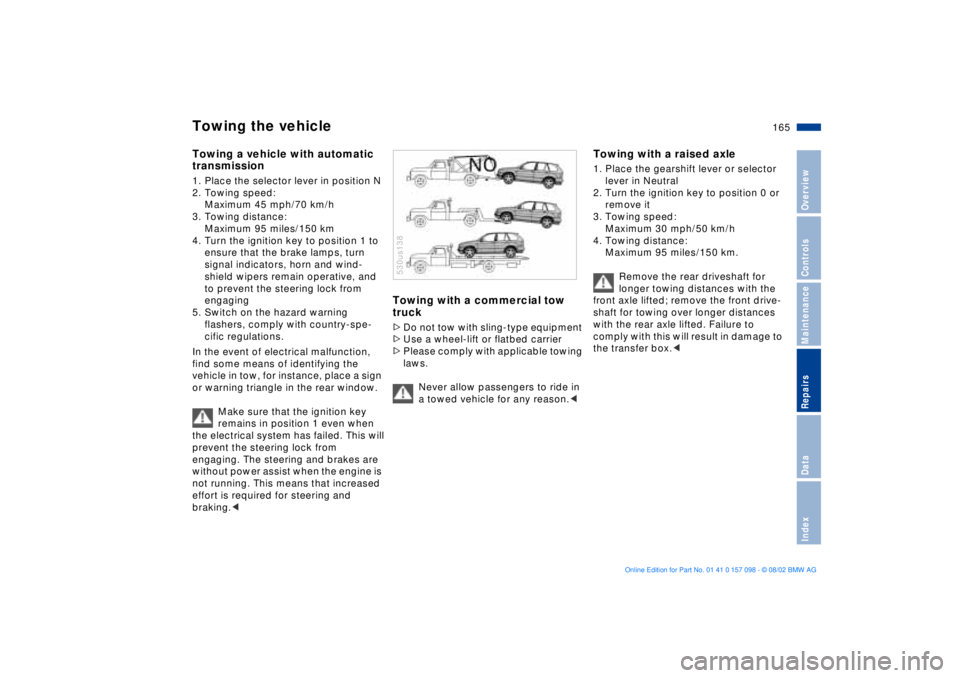Page 155 of 183
155n
OverviewControlsMaintenanceRepairsDataIndex
Changing a wheel What you will need In order to avoid rattling noises later,
note the position of the tools when you
remove them and return them to their
original position when you are through
using them.
>Two wedges Ð wheel chocks
Open the liftgate and tailgate.
In the cargo area, fold up the floor
cover or pull-out cargo floor, refer to
pages 123, 124 or 125.
Take out the wedges, refer to arrow,
next to the spare wheel 530us117
>Lug wrench
Is located next to the spare wheel 530us120
>Handle for the jack
Remove from its holder530de213
Page 157 of 183
157n
OverviewControlsMaintenanceRepairsDataIndex
Changing a wheel 3. Hook both buckles into the latch of
the tailgate, refer to arrow; the tail-
gate is released530de311
4. Remove the support rod from the
bracket 530de312
5. Press the tailgate down and hold it
there. The spare wheel is now pulled
by means of the removal aid onto the
tailgate
Hold the tailgate in the opened
position and do not allow it to
retract sharply upward. If you do so,
there is a risk of personal injury and
vehicle damage.< 530de313
Page 159 of 183

159n
OverviewControlsMaintenanceRepairsDataIndex
Changing a wheel9. Position the spare wheel. Secure
the wheel by turning at least two
lug bolts into opposite bolt holes
10. Screw in the remaining lug bolts.
Tighten all the bolts securely
11. Lower the jack and remove it from
beneath the vehicle
12. Tighten the lug bolts in a diagonal
pattern
13. Check and correct the tire inflation
pressure at the earliest opportunity.
Vehicles with Tire Pressure Monitor
RDC
*:
After mounting the spare wheel or
correcting the tire inflation pres-
sure, reactivate the system, refer to
page 97.
Protect valve stems and valves from dirt
using screw-on valve stem caps. Dirt in
the valve stems frequently leads to slow
leaks.The vehicle jack is designed for
changing wheels only. Do not
attempt to raise another vehicle model
with it or to raise any load of any kind.
To do so could cause accidents and
personal injury.
To ensure continued safety, have the
tightness of the lug bolts checked with
a calibrated lug wrench Ð torque speci-
fication: 101 lb-ft/140 Nm Ð at the
earliest opportunity.<
Store the wheel and the tools in the
order opposite that for removal.
Before removing the support rod,
be sure that the tailgate is held
down firmly. If you fail to do so, it could
retract sharply upward and cause per-
sonal injury and vehicle damage.
After you remove the rod, close the tail-
gate carefully. Continue to hold it firmly
until it is completely closed.<
If light-alloy wheels other than original
BMW light-alloy wheels have been
mounted, it may be necessary to use
different lug bolts for those wheels.
Replace the defective tire as soon as
possible and have the new wheel/tire
balanced. Driving with spare wheel
With certain wheel-and-tire com-
binations the size of the spare
wheel differs from that of the other
wheels. The spare wheel is equivalent
to these in all speed and load ranges.
However, to restore the original state,
the normal wheel should be remounted
as soon as possible.
When the spare wheel is mounted, the
maximum speed rating is 130 mph/
210 km/h.<
Page 160 of 183

160n
Battery Fuses
Battery posts, terminals and
related accessories contain lead
and lead compounds. Wash hands after
handling.<
MaintenanceThe battery is maintenance-free, that is,
the original electrolyte will normally last
for the service life of the battery under
moderate climatic conditions.
For all questions that regard the
battery, please consult your
BMW Sports Activity Vehicle center.
Since the battery is maintenance-free,
the following is for your information
only.<
Do not disconnect the battery
when the engine is running. If
you do so, the ensuing voltage surge
will damage the vehicle's onboard elec-
tronics.<
Charging the battery Charge the battery in the vehicle only
when the engine is not running. Use the
connections provided in the engine
compartment. For correct connections,
refer to Jump-starting on page 162. Disposal
Return used batteries to a recyc-
ling point or your BMW Sports
Activity Vehicle center. Maintain the
battery in an upright position for trans-
port and storage. Secure the battery
against tilting during transport.<
In the glove compartmentOpen the glove compartment and turn
the two quick-release fasteners to the
left. 530us121
Page 161 of 183
161n
OverviewControlsMaintenanceRepairsDataIndex
FusesIn the cargo areaOpen the right cover by pulling the
handle.
Do not attempt to repair a burned
fuse or replace it with a fuse
having a different color or ampere
rating. To do this could cause a fire in
the vehicle resulting from a circuit over-
load.< 530us122
Page 163 of 183

163n
OverviewControlsMaintenanceRepairsDataIndex
Jump-starting 5. With the second jumper cable, con-
nect the negative terminals of the
two vehicles. First connect the cable
to the support vehicle's negative bat-
tery terminal or a suitable ground on
its engine or bodywork, and then the
other end to the negative battery ter-
minal or a suitable ground on the
engine or bodywork of the vehicle
being started. There is a special nut
for this purpose on the left side panel
of your BMW, refer to the arrow in
the illustration
Always adhere to this sequence
when connecting jumper cables;
failure to observe this procedure can
lead to sparks at the battery terminals
and pose an injury hazard.< 530us127
6. Start the support vehicle's engine
and let it run at an increased idling
speed for a few minutes
7. Start the engine on the vehicle
needing the jump-start, and allow it
to run as usual. If the first start
attempt is not successful, wait a few
minutes before another attempt in
order to allow the discharged battery
to recharge
8. Before disconnecting the jumper
cables let the engines run for a few
minutes
9. Then disconnect the jumper cables
in reverse sequence.
Depending on the cause of the fault,
have the battery recharged by your
BMW Sports Activity Vehicle center.
Do not use spray starter fluids to
start the engine.<
Page 165 of 183

165n
OverviewControlsMaintenanceRepairsDataIndex
Towing the vehicle Towing a vehicle with automatic
transmission1. Place the selector lever in position N
2. Towing speed:
Maximum 45 mph/70 km/h
3. Towing distance:
Maximum 95 miles/150 km
4. Turn the ignition key to position 1 to
ensure that the brake lamps, turn
signal indicators, horn and wind-
shield wipers remain operative, and
to prevent the steering lock from
engaging
5. Switch on the hazard warning
flashers, comply with country-spe-
cific regulations.
In the event of electrical malfunction,
find some means of identifying the
vehicle in tow, for instance, place a sign
or warning triangle in the rear window.
Make sure that the ignition key
remains in position 1 even when
the electrical system has failed. This will
prevent the steering lock from
engaging. The steering and brakes are
without power assist when the engine is
not running. This means that increased
effort is required for steering and
braking.<
Towing with a commercial tow
truck >Do not tow with sling-type equipment
>Use a wheel-lift or flatbed carrier
>Please comply with applicable towing
laws.
Never allow passengers to ride in
a towed vehicle for any reason.< 530us138
Towing with a raised axle 1. Place the gearshift lever or selector
lever in Neutral
2. Turn the ignition key to position 0 or
remove it
3. Towing speed:
Maximum 30 mph/50 km/h
4. Towing distance:
Maximum 95 miles/150 km.
Remove the rear driveshaft for
longer towing distances with the
front axle lifted; remove the front drive-
shaft for towing over longer distances
with the rear axle lifted. Failure to
comply with this will result in damage to
the transfer box.<
Page 167 of 183
167n
OverviewControlsMaintenanceRepairsDataIndex
Overview
Controls and features
Operation, maintenance
Index Technical data
Index
Owner service procedures